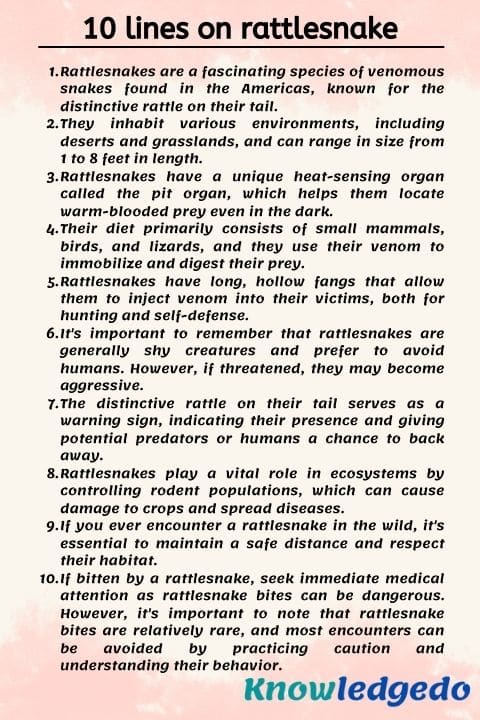Today, we are sharing 10 lines on rattlesnakes in English. This article can help students who are looking for information about 10 lines on rattlesnake. This Lines is very simple and easy to remember. The level of these Lines is moderate so any student can write on this topic.
This article is generally useful for class 1,class 2,class 3,class 4,class 5,class 6,class 7,class 8,class 9,class 10,class 11,class 12
10 lines on rattlesnake
1) Rattlesnakes are a fascinating species of venomous snakes found in the Americas, known for the distinctive rattle on their tail.
2) They inhabit various environments, including deserts and grasslands, and can range in size from 1 to 8 feet in length.
3) Rattlesnakes have a unique heat-sensing organ called the pit organ, which helps them locate warm-blooded prey even in the dark.
4) Their diet primarily consists of small mammals, birds, and lizards, and they use their venom to immobilize and digest their prey.
5) Rattlesnakes have long, hollow fangs that allow them to inject venom into their victims, both for hunting and self-defence.
6) It’s important to remember that rattlesnakes are generally shy creatures and prefer to avoid humans. However, if threatened, they may become aggressive.
7) The distinctive rattle on their tail serves as a warning sign, indicating their presence and giving potential predators or humans a chance to back away.
8) Rattlesnakes play a vital role in ecosystems by controlling rodent populations, which can cause damage to crops and spread diseases.
9) If you ever encounter a rattlesnake in the wild, it’s essential to maintain a safe distance and respect their habitat.
10) If bitten by a rattlesnake, seek immediate medical attention as rattlesnake bites can be dangerous. However, it’s important to note that rattlesnake bites are relatively rare, and most encounters can be avoided by practising caution and understanding their behaviour.

5 lines on rattlesnake
1) Rattlesnakes are venomous snakes known for the distinctive rattling sound they make with their tail.
2) They are found in the Americas and inhabit various environments like deserts and grasslands.
3) Rattlesnakes play an important role in balancing ecosystems by controlling populations of rodents.
4) It’s important to give rattlesnakes space and not provoke them if encountered in the wild.
5) If bitten by a rattlesnake, seek immediate medical attention as their bites can be dangerous.
FAQ
Answer: No, all rattlesnakes are venomous to some extent. They possess venom glands and hollow fangs that allow them to inject venom into their prey or potential threats. However, the potency of their venom can vary between different species and individuals.
Answer: No, rattlesnakes are not able to hear the sound of their own rattles. The rattle is made up of segments of keratin, the same material as our fingernails. When the rattlesnake shakes its tail, these segments collide and produce a distinctive buzzing sound. It serves as a warning to potential predators or threats.
Answer: If you encounter a rattlesnake in the wild, it is important to give it space and not provoke or attempt to handle it. Rattlesnakes are generally shy and will usually try to avoid humans. Back away slowly and leave the area. Keeping a safe distance is crucial to avoid potential bites. If bitten, seek immediate medical attention as rattlesnake bites can be dangerous and require specialized treatment.
